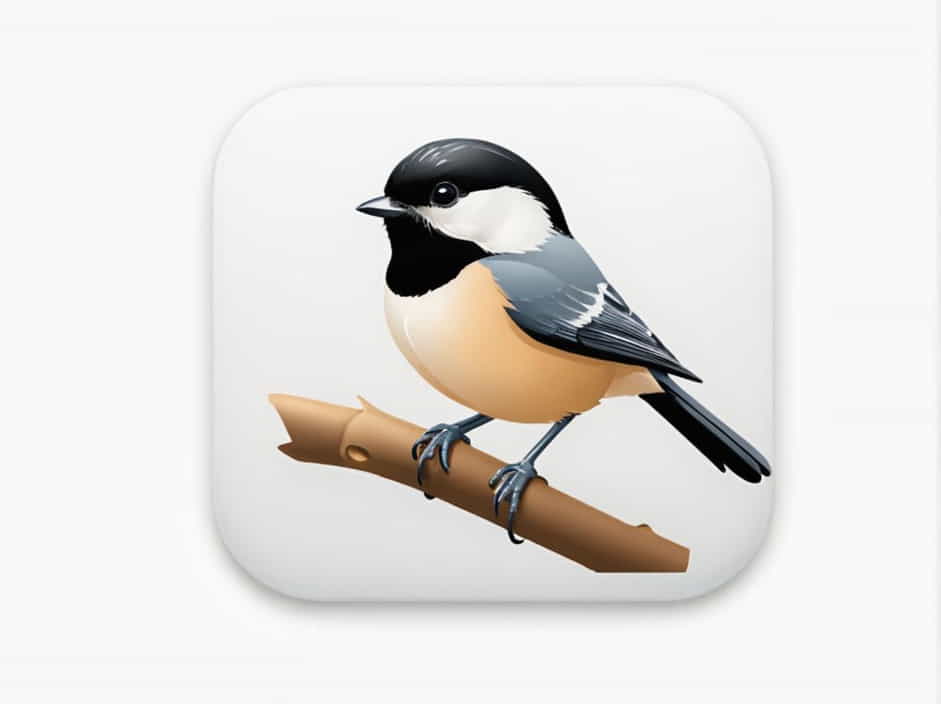The chickadee is a small, energetic bird known for its cheerful personality and distinctive call. These tiny birds are common in North America and can be found in forests, backyards, and even urban parks. Their friendly nature and curiosity make them a favorite among birdwatchers.
In this topic, we will explore the appearance, habitat, behavior, and significance of chickadees in the ecosystem.
1. What Does a Chickadee Look Like?
Chickadees are small songbirds with a distinctive black cap and bib, giving them an adorable and recognizable look.
Physical Features of a Chickadee
- Size: Small, measuring about 4.5 to 6 inches (11-15 cm) in length.
- Weight: Weighs only 0.3 to 0.5 ounces (8-14 grams).
- Plumage: Soft gray feathers on the back, with a white underside.
- Head Markings: A black cap and black throat bib, contrasting with white cheeks.
- Tail: Long and slightly rounded, helping with quick movements.
Their round, fluffy bodies and large heads make them easy to recognize, especially in winter when their feathers puff up to keep warm.
2. Common Species of Chickadees
There are several species of chickadees, each with slightly different markings and habitats.
Popular Chickadee Species
✔️ Black-Capped Chickadee (Poecile atricapillus): The most recognizable species, found in northern North America.
✔️ Carolina Chickadee (Poecile carolinensis): Found in the southeastern U.S., slightly smaller than the black-capped chickadee.
✔️ Mountain Chickadee (Poecile gambeli): Lives in high-altitude forests and has a white eyebrow stripe.
✔️ Boreal Chickadee (Poecile hudsonicus): Prefers cold, dense forests in Canada and Alaska.
✔️ Chestnut-Backed Chickadee (Poecile rufescens): Found along the Pacific Coast, with a rusty-colored back.
Each species has unique adaptations to thrive in its specific environment.
3. Where to Find Chickadees
Natural Habitat
Chickadees are highly adaptable birds that live in a variety of environments. They are commonly found in:
- Deciduous and mixed forests
- Suburban and urban gardens
- Parks and nature reserves
- Mountainous regions (for species like the Mountain Chickadee)
How to Spot a Chickadee
- Listen for their famous “chick-a-dee-dee-dee” call.
- Look for small, active birds flitting between tree branches.
- Check bird feeders, especially in winter.
Their curiosity often makes them unafraid of humans, so they may come close if you remain still and quiet.
4. What Do Chickadees Eat?
Chickadees have a varied diet that changes with the seasons.
Favorite Foods of Chickadees
✔️ Insects and Spiders – Essential in summer, making up most of their diet.
✔️ Seeds and Berries – Especially important in fall and winter.
✔️ Tree Sap – Occasionally consumed, like a small woodpecker.
✔️ Nuts and Suet – Popular at backyard feeders.
Chickadees are also known for hiding food for later, storing seeds in tree crevices to survive cold months.
5. How Chickadees Survive the Winter
Unlike some birds that migrate, chickadees stay in the same area year-round, even in freezing temperatures.
Winter Survival Strategies
✔️ Fluffing up their feathers to trap heat.
✔️ Roosting in tree cavities to stay warm at night.
✔️ Shivering to generate heat (without wasting too much energy).
✔️ Cashing food (storing seeds in hidden spots).
These adaptations help them endure harsh winters, even in the coldest regions.
6. Why Are Chickadees Important to the Ecosystem?
Chickadees play a vital role in their habitat by controlling insect populations and spreading seeds.
Benefits of Chickadees in Nature
- Insect Control: They eat caterpillars and other pests that damage trees.
- Seed Dispersal: They help spread seeds, aiding plant growth.
- Prey for Larger Birds: They support the food chain by feeding hawks and owls.
Because of their role in maintaining ecological balance, chickadees are essential to healthy forest environments.
7. How to Attract Chickadees to Your Yard
Chickadees are easy to attract if you provide food, shelter, and water.
Tips for Attracting Chickadees
✔️ Use Bird Feeders: Offer black oil sunflower seeds, suet, and peanuts.
✔️ Provide Nesting Boxes: They prefer small, enclosed spaces.
✔️ Grow Native Plants: Trees like oak, birch, and maple attract insects they feed on.
✔️ Avoid Pesticides: Healthy insect populations help support chickadees.
By making your yard bird-friendly, you can enjoy these cheerful visitors all year.
8. Fun Facts About Chickadees
✔️ They remember thousands of food locations! Chickadees can recall where they stored seeds for months.
✔️ Their brains shrink and regrow. In winter, their brain changes to help them survive.
✔️ They can lower their body temperature at night. This saves energy in freezing conditions.
✔️ They are fearless around humans. Some will even take seeds from your hand!
✔️ Their name comes from their call. The “chick-a-dee-dee” sound helps them communicate.
These little birds are not only intelligent but also fascinating to observe.
9. Are Chickadees Endangered?
Thankfully, most chickadee species have stable populations and are listed as Least Concern by conservation groups. However, threats still exist:
Challenges Chickadees Face
Habitat Loss – Deforestation removes their nesting sites.
Climate Change – Alters food availability and migration patterns.
Predation – Cats and larger birds prey on them.
Protecting forests and creating safe backyard habitats can help ensure their future survival.
The Charming Chickadee
Chickadees are small but mighty birds that bring joy to birdwatchers and nature lovers alike. Their cute appearance, bold personality, and fascinating survival skills make them stand out among songbirds.
Key Takeaways:
✔️ Recognizable by their black cap, white cheeks, and fluffy bodies.
✔️ Live in forests, parks, and backyards across North America.
✔️ Eat insects, seeds, and store food for winter.
✔️ Stay active even in freezing temperatures.
✔️ Easy to attract with bird feeders and native trees.
Next time you see a small, energetic bird hopping from branch to branch, take a closer look—you might just be watching a chickadee!
